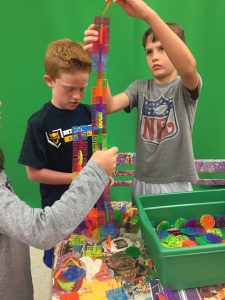TL;DR:
- Having a maker mindset can encourage students to be creative and explore.
- A maker space is not necessary for providing these opportunities for students.
- Curated materials and time are all students need.

- It can be the perfect activity to end the year.
State testing is over. We’ve covered the curriculum. Students are unruly and impatient for summer. How do teachers continue to engage students without resorting to a lot of screen time? The end of the school year is a great opportunity to dabble in creative projects. Students and teachers can focus on creating a maker mindset.
The idea of a maker mindset encourages students to explore, collaborate, and experiment. And as the name implies, it allows them to “make stuff.” The “stuff” can be curriculum-based. However, it also provides opportunities for students to use their imagination and creative skills to build/invent/fabricate something new. Taking time to create a space for learning, selecting versatile materials, and developing a set of lessons will ensure the beginnings of a maker mindset.
The idea of a maker mindset encourages students to explore, collaborate, and experiment. And as the name implies, it allows them to 'make stuff.' Share on XA Dedicated Space
A dedicated school maker space is the ultimate goal. Effective places can even be a corner of a library. An old computer room. Bins in a classroom where materials and projects are stored. When students enter that space, they should feel empowered, excited, and ready to explore. Materials are displayed for easy access. In addition, you have a system for easy clean-up in place. When they enter that space, students know collaboration, creativity, and mistakes are encouraged.
Curate Materials

Curating a collection of materials that is versatile and portable is the next priority. First, organize a combination of consumable materials (hot glue gun sticks, tape, and so much cardboard) and reusable materials (magnetic blocks, Legos).
Go-to materials include Keva Planks for building and Hummingbird kits that easily combine coding and recycled material projects. Next-level materials might include sewing machines, a laser cutter, and other codable robots that can be used in conjunction with the recycled materials.
Also, having STEM bins with challenge cards and a variety of materials like popsicle sticks, toothpicks, and clay on a cart would encourage teachers to implement the lessons with delivered materials. While materials alone offer little time for students to engage with new things, having some time to build will give them new ways to think about learning.
[scroll down to keep reading]Tinker Time
It may be tough to devote a special space and materials to begin the shift to a maker mindset. However, trying out lessons and allowing students to tinker and explore is just as effective. Maker lessons give students opportunities to explore areas typically not found in the many classrooms. This includes fabrication (sewing), design (Tinkercad/3D printing), coding, building, inventing, etc.
Some good end-of-the-year projects could include the egg drop or a boat-building challenge. Another example is a “Chopped” type lesson where students have a box/bin of random materials and create something out of them. You could also hold a “build the tallest tower” competition with magnet blocks, straws, or wooden planks. Sometimes a picture book is the best place to start. Other times, give the kids some tinker time and let them explore. Creating a maker mindset can be easy given the right opportunities, even at the end of May!
About Bridget Belardi
Bridget Belardi is a librarian and makerspace coordinator at Foster Elementary School in Mt. Lebanon School District in Pittsbugh, PA. She is also the school Tech Coach, an adjunct professor at Wilson College and board member for wonderful organizations like Matt’s Makerspace and Education Blueprint.



